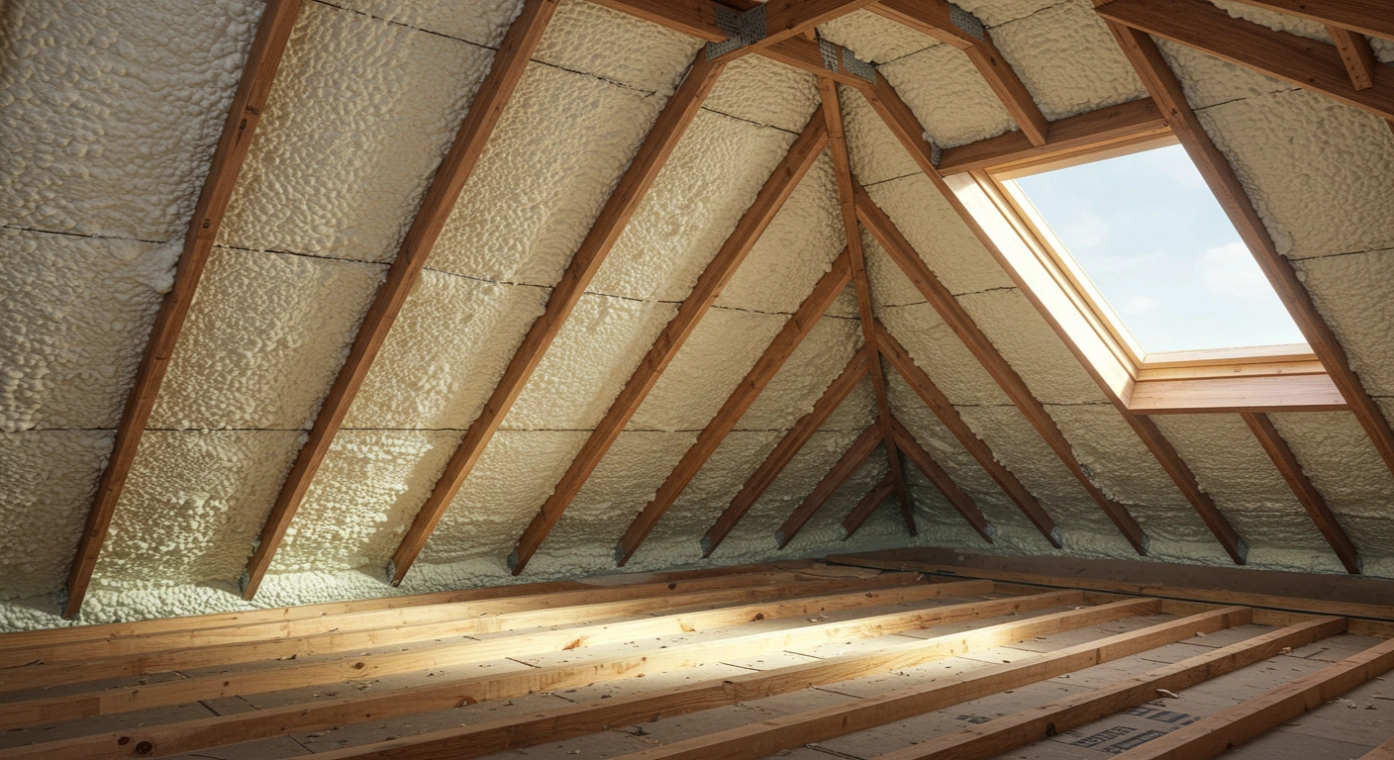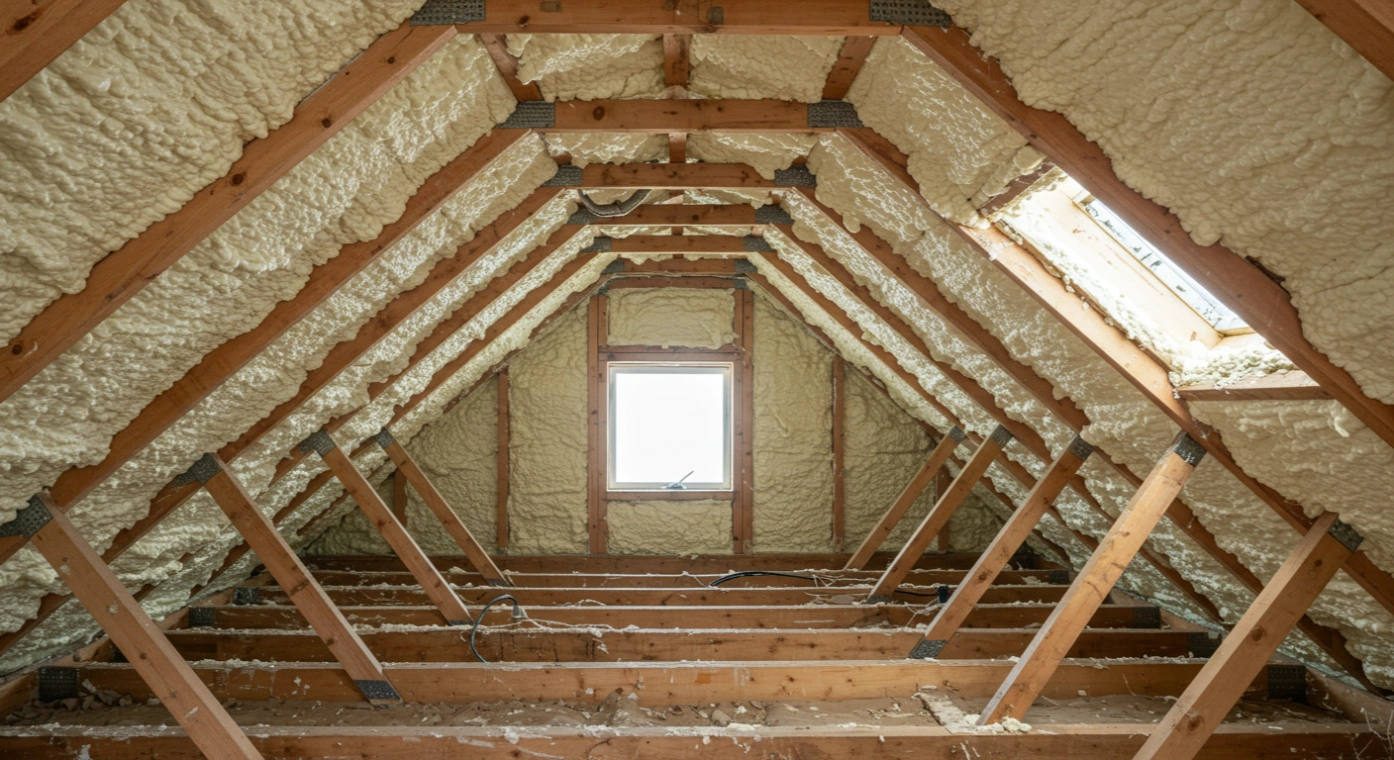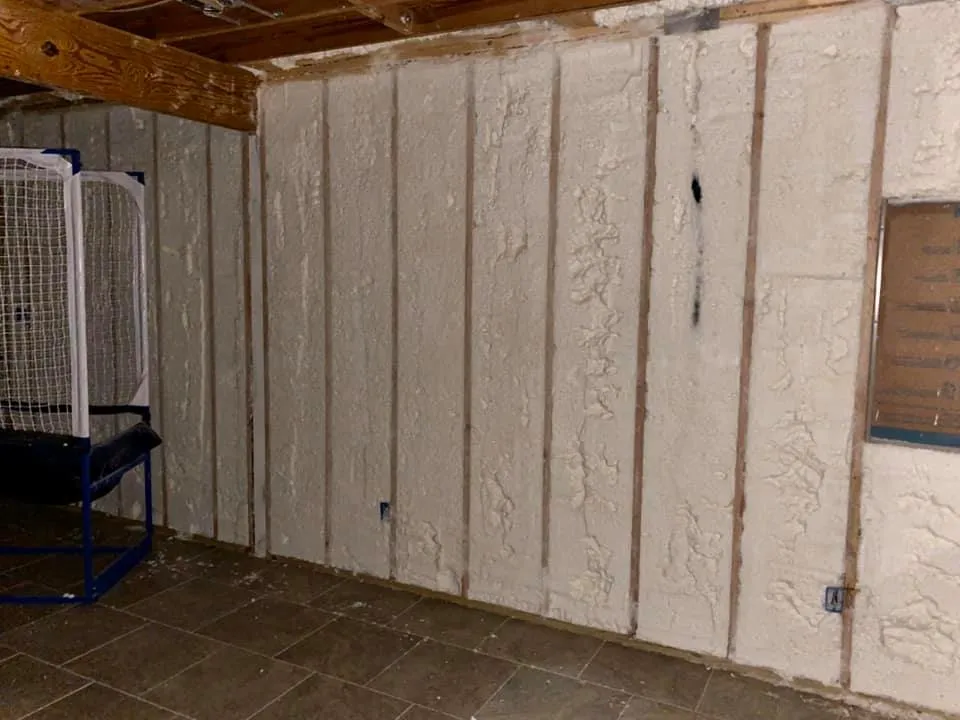Closed-cell foam becomes the optimal attic insulation choice when moisture control, structural reinforcement, and maximum thermal performance are priorities. This insulation type works best in climate zones with extreme temperature fluctuations, homes with recurring moisture issues, or structures requiring enhanced air sealing capabilities.
The decision hinges on specific performance requirements rather than general insulation needs. Closed-cell foam delivers superior moisture resistance, higher R-value per inch, and structural benefits that traditional insulation materials cannot match. Professional contractors with extensive experience installing various insulation types recognize these distinct advantages when evaluating attic conditions and homeowner requirements.
Understanding Closed-Cell Foam Performance Characteristics
Closed-cell spray polyurethane foam consists of tiny, sealed cells that prevent air and moisture penetration. Each cell structure maintains its integrity under temperature variations and atmospheric pressure changes. The material expands during application, creating a continuous thermal barrier that eliminates gaps and thermal bridges.
The cellular structure provides both insulation and vapor barrier properties simultaneously. Unlike open-cell alternatives, moisture cannot penetrate the closed-cell matrix, preventing condensation issues that plague many attic spaces. This dual functionality reduces installation complexity while improving long-term performance reliability.
Bonus Tip: Test existing attic moisture levels before installation using a moisture meter. Readings above 15% indicate underlying issues that closed-cell foam can address effectively.
| Closed-Cell Foam vs Other Attic Insulation Options | R-Value per Inch | Moisture Resistance | Air Sealing | Structural Support | Installation Complexity |
|---|---|---|---|---|---|
| Closed-Cell Foam | 6.0-7.0 | Excellent | Complete | Yes | High |
| Open-Cell Foam | 3.5-4.0 | Poor | Good | Limited | Medium |
| Fiberglass Batts | 3.1-3.4 | Poor | Minimal | No | Low |
| Blown Cellulose | 3.2-3.8 | Fair | Good | No | Medium |
Climate Conditions That Favor Closed-Cell Applications
Extreme temperature zones benefit significantly from closed-cell foam’s thermal performance. Regions experiencing temperature swings exceeding 40 degrees between seasons create challenging conditions for traditional insulation materials. The foam’s structural integrity remains stable across these temperature ranges.
High humidity environments present another compelling application scenario. Areas with consistent relative humidity above 60% create condensation risks in traditional attic insulation systems. Closed-cell foam eliminates moisture accumulation by preventing humid air from reaching dew point temperatures within the insulation layer.
According to the North American Insulation Manufacturers Association, homes in climate zones 4-8 show measurable energy efficiency improvements when closed-cell foam replaces traditional attic insulation, particularly in mixed-humid and cold climates.
Technical Specifications and Performance Data
| Technical Performance Metrics | Value | Standard | Significance |
|---|---|---|---|
| Density | 2.0 lbs/ft³ | ASTM D1622 | Structural integrity |
| Compressive Strength | 25-50 psi | ASTM D1621 | Load-bearing capacity |
| Water Absorption | <2% | ASTM D2842 | Moisture resistance |
| Thermal Conductivity | 0.021 BTU·in/hr·ft²·°F | ASTM C518 | Heat transfer rate |
| Vapor Permeability | 0.8 perms at 1 inch | ASTM E96 | Moisture barrier |
These specifications demonstrate closed-cell foam’s superior performance in moisture-prone environments. The low vapor permeability rating qualifies the material as a Class II vapor retarder, eliminating the need for separate vapor barrier installation.
Structural and Air Sealing Benefits
Closed-cell foam adds measurable structural strength to attic assemblies. The material bonds directly to framing members, creating a composite structure that increases overall building stiffness. This characteristic proves valuable in older homes with compromised structural elements or areas prone to wind loading.
Air infiltration reduction represents another significant advantage. Traditional insulation methods leave gaps around electrical penetrations, ductwork, and framing irregularities. Closed-cell foam expands into these spaces, creating a monolithic air barrier that reduces heating and cooling loads substantially.
Bonus Tip: Schedule installation during moderate temperature conditions (50-80°F) for optimal foam expansion and curing. Extreme temperatures affect application consistency and final performance.
Things to Consider Before Making a Decision
Several factors determine whether closed-cell foam suits specific attic applications. Budget considerations rank prominently, as closed-cell foam requires higher initial investment compared to traditional insulation options. However, long-term energy savings and reduced maintenance costs often justify the premium.
Existing ventilation systems require evaluation before installation. Closed-cell foam creates an unvented attic assembly, eliminating the need for soffit and ridge ventilation. This change affects HVAC system placement and may require ductwork modifications in some configurations.
Building code compliance varies by jurisdiction regarding unvented attic assemblies. Local authorities may require specific thermal barrier applications or fire-resistant coatings over exposed foam surfaces. Professional contractors familiar with regional requirements ensure compliant installations.
Access limitations in tight attic spaces can complicate installation procedures. Closed-cell foam requires specialized spray equipment and adequate working space for proper application. Attics with low clearances or numerous obstructions may necessitate alternative approaches or partial application strategies.

Professional Installation Services Stellrr Provides
- Residential Spray Foam Insulation: Complete attic encapsulation using closed-cell foam technology, including thermal barrier application and code compliance verification.
- Attic Insulation: Comprehensive attic conditioning services combining closed-cell foam with mechanical ventilation systems for optimal indoor air quality.
- Insulation Removal: Safe removal of existing insulation materials before closed-cell foam installation, including contaminated or damaged insulation remediation.
- Commercial Spray Foam Insulation: Large-scale closed-cell foam applications for commercial buildings requiring superior moisture control and thermal performance.
Common Questions About Closed-Cell Foam Selection
Is closed-cell spray foam right for my home?
Homeowners frequently question whether closed-cell foam suits their specific situation. The primary determining factors include moisture history, energy efficiency goals, and structural requirements. Properties with previous water intrusion issues benefit significantly from closed-cell foam’s moisture resistance.
When is the best time to install closed-cell spray foam?
Installation timing concerns often arise during project planning. Closed-cell foam installation requires dry conditions and adequate curing time. Weather delays can affect project schedules, particularly during humid seasons when extended drying periods become necessary.
What performance should I expect from closed-cell spray foam?
Performance expectations need realistic assessment before installation. While closed-cell foam delivers superior thermal performance, existing air leaks in walls and foundations can limit overall efficiency gains. Comprehensive air sealing throughout the building envelope maximizes closed-cell foam benefits.
Bonus Tip: Document existing attic conditions with photographs before installation. This documentation proves valuable for warranty claims and future maintenance planning.
Research from the Department of Energy indicates that properly installed closed-cell foam can reduce heating and cooling costs by 15-30% in climate-appropriate applications, with payback periods typically ranging from 7-12 years depending on local energy costs.
Making the Right Choice for Your Home
Closed-cell foam excels in specific applications where moisture control, air sealing, and thermal performance converge as priorities. The material’s higher cost becomes justified when traditional insulation cannot address underlying moisture issues or when maximum energy efficiency is required.
Evaluate your attic’s current condition, local climate demands, and long-term occupancy plans before making the final decision. Properties in high-moisture environments or extreme climate zones typically see the greatest return on closed-cell foam investment.
Get Professional Assessment and Installation
Determining whether closed-cell foam suits your attic requires professional evaluation of existing conditions, climate factors, and performance goals. Each application presents unique challenges that experienced contractors can identify and address effectively.
Stellrr provides comprehensive attic insulation assessments and professional installation services throughout the region. Contact info@stellrr.com or call (512) 710-2839 to schedule a detailed evaluation of your attic’s insulation needs and discuss closed-cell foam options for your specific situation.
Expert Answers to Key Questions
How long does closed-cell foam last in attic applications?
Properly installed closed-cell foam maintains its thermal and structural properties for 30-50 years under normal conditions. The material resists degradation from temperature cycling, moisture exposure, and settling that affects traditional insulation materials. Regular inspection every 5-7 years ensures optimal performance throughout its service life.
Can closed-cell foam cause moisture problems in other building areas?
Closed-cell foam prevents moisture movement through the attic assembly, which can redirect moisture to other building components if vapor barriers are improperly installed elsewhere. Professional installation includes evaluation of the entire building envelope to prevent unintended moisture accumulation in walls or basement areas.
Does closed-cell foam require special fire safety considerations?
Building codes require thermal barriers over exposed closed-cell foam in occupied spaces. Attic applications typically use intumescent coatings or gypsum board to meet fire safety requirements. Professional contractors ensure compliance with local fire codes during installation planning and execution.
Will closed-cell foam affect my home’s resale value?
High-performance insulation systems, including closed-cell foam, generally increase property values by improving energy efficiency ratings and reducing utility costs. Energy-efficient homes command premium prices in most markets, particularly in regions with extreme climates where insulation performance significantly impacts comfort and operating costs.
How does closed-cell foam installation affect existing HVAC systems?
Converting to an unvented attic assembly using closed-cell foam allows HVAC equipment and ductwork to operate within conditioned space, improving system efficiency. However, existing ventilation strategies may require modification to maintain proper indoor air quality. Professional evaluation determines necessary HVAC adjustments before foam installation.





